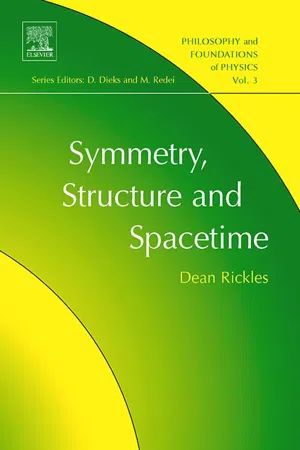1.1 INTERPRETATION AND ONTOLOGY
Can philosophers really contribute to the project of reconciling general relativity and quantum field theory? Or is this a technical business best left to the experts? [.] General relativity and quantum field theory are based on some profound insights about the nature of reality. These insights are crystallized in the form of mathematics, but there is a limit to how much progress we can make by just playing around with this mathematics. We need to go back to the insights behind general relativity and quantum field theory, learn to hold them together in our minds, and dare to imagine a world more strange, more beautiful, but ultimately more reasonable than our current theories of it. For this daunting task, philosophical reflection is bound to be of help. ([Baez, 2001], p. 177)
Although one might not guess it from the above quote, in recent times physicists and philosophers of physics have tended to tread very different paths, and they have generally been a little suspicious of one another. As Michael Redhead points out in the first of his Tarner lectures, "many physicists would dismiss the sort of question that philosophers of physics tackle as irrelevant to what they see themselves as doing" while "philosophers generally regard physicists as naive people, who do physics in an uncritical way" ([1996], pp. 1-2). Reichenbach expresses much the same point even more strongly, suggesting that there is a "mutual contempt in which each misunderstands the purposes of the other's endeavours" ([1958], p. xi).
This hasn't always been the case, of course. As Reichenbach notes, "[t]he classical philosophers had a close connection with the science of their times" (ibid.), Descartes and Leibniz being fine examples. In addition to this, historically, each time a fundamental revolution has occurred in physics (Newtonian mechanics; the relativity theories; quantum theory, etc.) there has generally been an associated shift to a more critical, reflective attitude towards theory construction. Indeed, Kuhn appears to suggest that such a shift is a necessary part of scientific revolutions:
It is no accident that the emergence of Newtonian physics in the seventeenth century and of relativity and quantum mechanics in the twentieth should have been both preceded and accompanied by fundamental philosophical analyses of the contemporary research tradition. ([Kuhn, 1970], p. 88)
Kuhn also seems to give a very accurate depiction of the present situation in quantum gravity1 when he writes that:
Confronted with anomaly or with crisis, scientists take a different attitude toward existing paradigms, and the nature of their research changes accordingly. The proliferation of competing articulations, the willingness to try anything, the expression of explicit discontent, the recourse to philosophy and the debate over fundamentals, all these are symptoms of a transition from normal to extraordinary research. ([1970], pp. 90-91)
One of the main aims of this book is to highlight the extent to which many problems of quantum gravity are predominantly 'philosophical' in their nature and origin—these spring in large part from aspects of the classical theory. But despite this, though physicists have been known to take up more philosophical attitudes in times of crisis, 'the philosophers' have previously remained firmly divided from the constructive practice of theory building in physics, waiting in the wings, as it were, until the theories were deemed sufficiently well established to warrant their attention.
The strange case of quantum gravity, as this book will try to show, offers us a place where philosophers might play a role in the more constructive parts of the foundations of physics—though, of course, it is highly doubtful that this will include an involvement in the technical foundations. Tian Yu Cao, believing consistency and conceptual clarity to be of the essence in quantum gravity (his point being, there is no experimental basis), makes a similar point:
this is a rare conjuncture for philosophers to intervene, with a good chance to make some positive contributions, rather than just analysing philosophically what physicists have already established. ([Cao, 2001], p. 183)
There are at least three reasons behind this possibility as I see it: (1) these days philosophers of physics are simply better equipped in terms of their command of the necessary parts of mathematics and physics required—most of them having done their original training and research in physics, and often publishing in physics journals, (2) quantum gravity is an area of physics lacking an experimental basis from which to test the various proposals, thus forcing conceptual and mathematical consistency to take center stage. What's more, (3) it appears that the kinds of conceptual problem that litter the field of quantum gravity are ones that philosophers are already well familiar with, as I have already suggested, and aim to show in more detail.2
Philosophers, however, have generally been rather slow to pick up the challenge of quantum gravity, seemingly more content to flog poor old non-relativistic quantum mechanics to death! This is made all the more surprising given that many researchers engaged in quantum gravity actively encourage the involvement of philosophers in their discipline. For example, Carlo Rovelli (one of the physicists who created the popular approach known as 'loop quantum gravity'—a genuinely viable alternative to string theory) explicitly voices this opinion:
As a physicist involved in this effort [quantum gravity], I wish the philosophers who are interested in the scientific description of the world would not confine themselves to commenting and polishing the present fragmentary physical theories, but would take the risk of trying to look ahead. ([Rovelli, 1997], p.182)
Up until very recently the same might have been said of (specially) relativistic quantum field theory, though lately there has been a definite shift of emphasis from non-relativistic quantum mechanics to relativistic quantum field theory— a very welcome move in my opinion. As welcome as this shift is though, methodologically the philosophy of relativistic quantum field theory is the same as non-relativistic quantum mechanics (and likewise subject to Rovelli's gripe): the mathematical and theoretical framework exists (admittedly, modulo certain nasty consistency problems...
